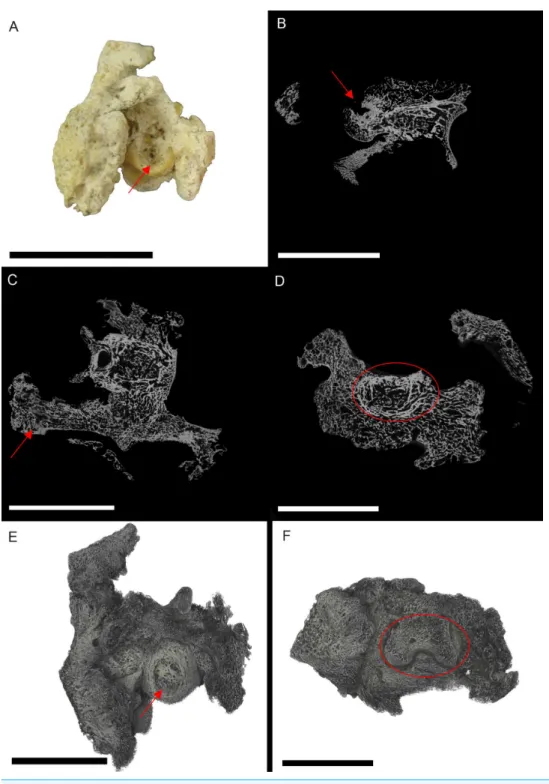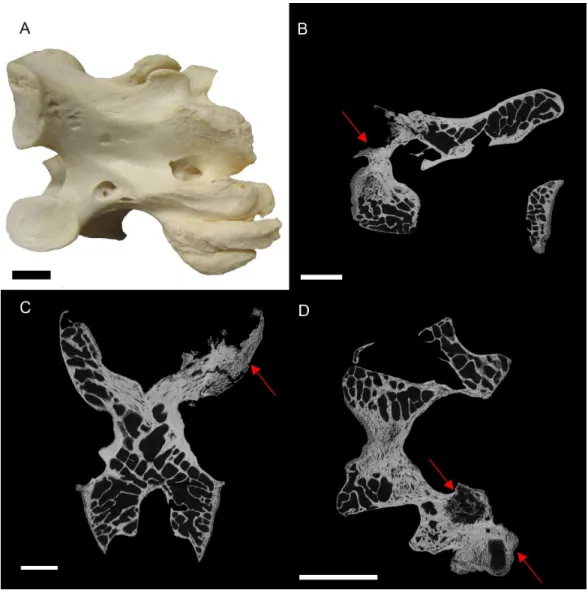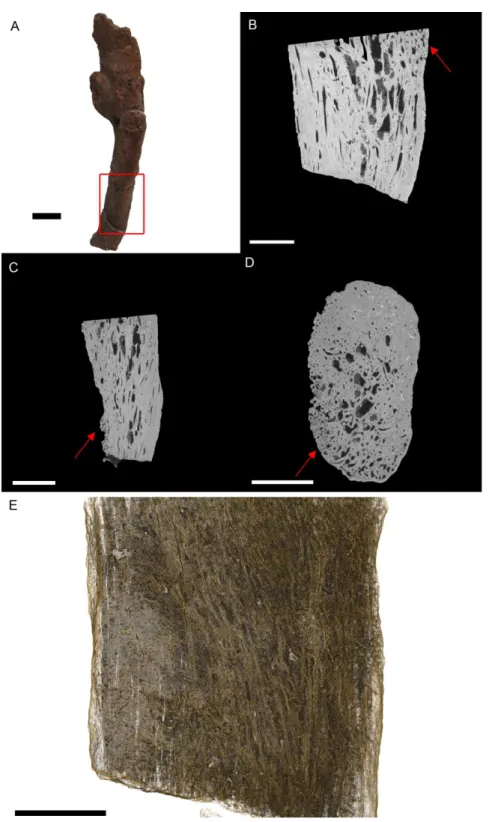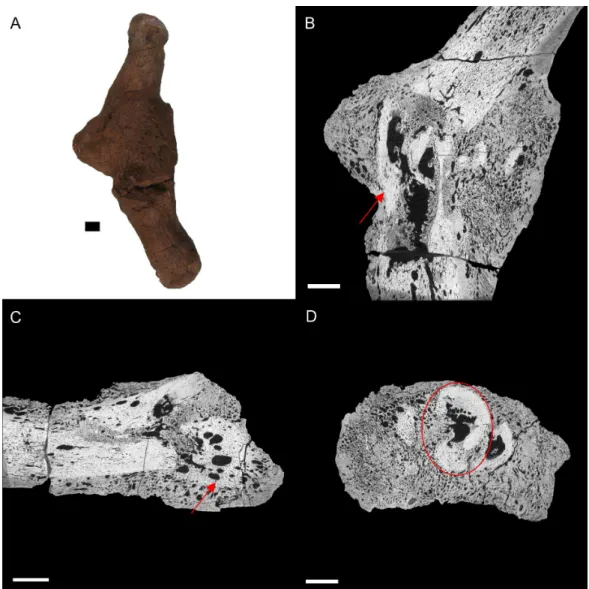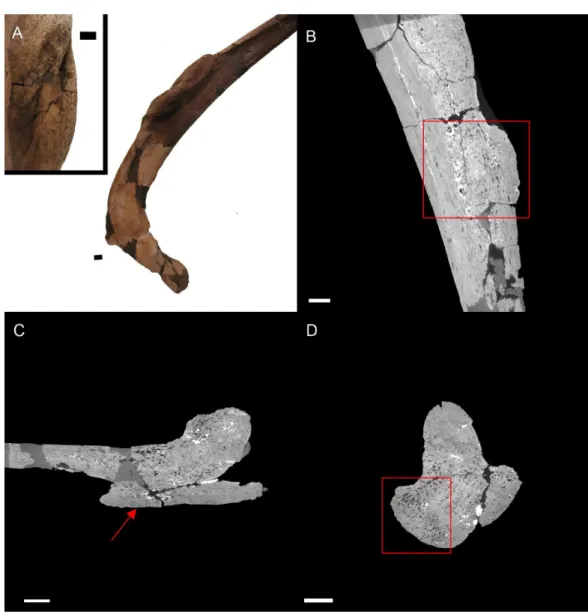Submitted 5 May 2015 Accepted 6 July 2015 Published28 July 2015
Corresponding author
Jennifer Ann´e,
jennifer.anne@manchester.ac.uk
Academic editor
Mar´ıa ´Angeles Esteban
Additional Information and Declarations can be found on page 11
DOI10.7717/peerj.1130
Copyright
2015 Ann´e et al.
Distributed under
Creative Commons CC-BY 4.0
OPEN ACCESS
Interpreting pathologies in extant and
extinct archosaurs using micro-CT
Jennifer Ann´e1, Russell J. Garwood1, Tristan Lowe2, Philip J. Withers2and Phillip L. Manning1
1School of Earth, Atmospheric and Environmental Sciences, University of Manchester, Manchester, UK 2Manchester X-ray Imaging Facility, School of Materials, University of Manchester, Manchester, UK
ABSTRACT
Palaeopathology offers unique insight to the healing strategies of extinct organ-isms, permitting questions concerning bone physiology to be answered in greater depth. Unfortunately, most palaeopathological studies are confined to external morphological interpretations due to the destructive nature of traditional meth-ods of study. This limits the degree of reliable diagnosis and interpretation possible. X-ray MicroTomography (micro-CT, XMT) provides a non-destructive means of analysing the internal three-dimensional structure of pathologies in both extant and extinct individuals, at higher resolutions than possible with medical scanners. In this study, we present external and internal descriptions of pathologies in extant and extinct archosaurs using XMT. This work demonstrates that the combination of external/internal diagnosis that X-ray microtomography facilitates is crucial when differentiating between pathological conditions. Furthermore, we show that the use of comparative species, both through direct analysis and from the literature, provides key information for diagnosing between vertebrate groups in the typical pathological conditions and physiological processes. Micro-CT imaging, combined with com-parative observations of extant species, provides more detailed and reliable interpre-tation of palaeopathologies. Micro-CT is an increasingly accessible tool, which will provide key insights for correctly interpreting vertebrate pathologies in the future.
Subjects Paleontology, Veterinary Medicine, Zoology, Histology
Keywords Palaeopathology, Micro-CT, Archosaur
INTRODUCTION
Table 1 External descriptions of specimens.External pathological description for extant and extinct archosaurs used in this study.
Species Skeletal element External pathological description
Sagittarius serpentarius(secretary bird) pedal phalanx NHM S/1869.2.16.1 Extreme bone growth; most of the digit is obscured Struthio camelus(ostrich) cervical vertebra BHI 6241 Bony growth on the postzygapothoses resulting
in pseudofusion of two vertebrae
Tyrannosaurus rex cervical rib BHI 3033 Extensive reactive bone throughout
Edmontosaurus annectens metacarpal BHI 6191 Rough fracture callus caused by angular displacement
Edmontosaurus annectens dorsal rib BHI 6184 Large “pursed” bony growth near rib head
fragile. Additionally, the two-dimensional nature of this technique does not capture the entire complexity of pathological tissue unless serial sections are made. The application of medical scanners to such material has allowed for non-destructive three-dimensional investigation of internal histologic superstructures, though the resolution may be low (Straight et al., 2009;Particelli et al., 2012;Sutton, Rahman & Garwood, 2014), and medical X-ray sources struggle to penetrate dense fossils.
Since the 1990s, XMT has revolutionised the study of fine and complex bone structures in medical (Englke et al., 1999;Particelli et al., 2012), forensic (Thali et al., 2003) and palaeontological studies (Straight et al., 2009;Sutton, Rahman & Garwood, 2014;Bishop et al., 2015;Foth et al., 2015). Such scanners can attain sub-micron resolution (depending on sample size) compared to the tenths of a millimetre in conventional medical scans (Englke et al., 1999;Sutton, Rahman & Garwood, 2014). XMT is usually applied to smaller samples, as the size of the area of interest dictates spatial resolution. However, by compromising the resolution of the scan (to tens of microns versus sub-micron), this technique can be applied to larger scan areas while maintaining higher resolution scans than is possible with medical scanners (which also struggle with large specimens due to their medium energy (20–150 kV)). For example, the Nikon custom bay microtomography system in the Manchester X-ray Imaging Facility (MXIF) houses a high energy source (225–320 keV) that, coupled with a 2,000×2,000 pixel detector, allows decimetre-scale specimens of fossil bone to be scanned at sub-100µm resolution. This level of detail
allows us to distinguish key internal morphological features required for an accurate diagnosis of palaeopathologies. Here we present XMT data from two extant and three extinct archosaurs exhibiting a variety of pathologies, further demonstrating that XMT is a powerful tool for the field of palaeopathology.
MATERIALS & METHODS
Specimens consisted of extant and extinct archosaur material with various pathological conditions that were identified based on external observations (Table 1).
Table 2 Table of scanning parameters.Experimental parameters used for scanning with the Nikon Metris Custom Bay (MXIF).
Species kV µA Filter
(mm)
Exposure (ms)
Voxel size (µm)
Total scan time (min)
Sagittarius serpentarius 50 150 none 1,000 16.6 55
Struthio camelus 60 170 1.5 Al 1,000 44.9 55
Tyrannosaurus rex 60 170 1.5 Al 1,000 15.3 55
Edmontosaurus annectens—metacarpal 115 115 0.25 Cu 500 47.9 30
Edmontosaurus annectens—rib 115 85 0.25 Cu 708 78 40
XMT scanning was conducted at the Manchester X-ray Imaging Facility (MXIF) using the Nikon Metris Custom Bay, a system which can accommodate large specimens (maximum field of view of 410 mm) and provide spatial resolutions between 100 and ∼3.5µm (Table 2). The system has a 225 kV static multi-metal anode target, which was set
to tungsten in order to achieve the maximum energy, to improve X-ray penetration of the scanned material (fossil and extant bone). The source voltage was set to 225 kV, and auto conditioned for 30 min prior to scanning to decrease the likelihood of the source cutting out while scanning. Specimens were mounted on a manipulation stage using a variety of plates and clamps depending on their size, weight, and geometry. Previous scans of this type of material have demonstrated that 15–20% transmission through the specimen relative to the flat field provide excellent scans. To achieve this aim, the source voltage and current were modified coupled with changing thicknesses of Cu or Al filters to minimise beam hardening but achieve an optimal spectral width and intensity. Exposure was selected to minimise scan times while collecting clean data (between 0.5 and 1.0 s exposure, sample dependent), and for all scans counts on the detector panel outside the sample were kept below 65,000 counts for the selected gain, which was set to minimum to reduce noise. For each sample, scanning parameters were selected to fit these requirements while using the lowest voltage possible to maximise the attenuation from photoelectric absorption and thus maximise contrast from compositional differences in the sample (Sutton, Rahman & Garwood, 2014). 3,142 projections were collected; a number based on the optimise option for the CT Pro acquisition software.
Volumes were reconstructed using the Nikon CT Pro software. Processed scans were converted to TIFF stacks using the HMtool in MATLAB®, which is an in-house script used by the MXIF. TIFFs or VGI/VOL files (the former for Volume Graphics’ VGStudio MAX) were opened using Fiji (Schindelin et al., 2012) for initial analysis of slice stacks. TIFFs were then opened in Avizo®to construct orthoslices, while VGI files were opened in Drishti for volume rendering (Limaye, 2006).
RESULTS AND DISCUSSION
plantar surface, with signs of necrosis internally. The concentric ring appearance within the necrotic area matches the description for a fibricess; a localised inflammatory process caused by the incomplete elimination of pathogens in archosaurs (Harmon, 1998; Huchz-ermyer & Cooper, 2000). The most likely cause is osteitis (inflammation of the bone by in-fection) or osteomyelitis (inflammation of bone marrow by infection;Ritchie, Harrison & Harrison, 1994;Berners, 2002). This diagnosis is based on the lesion on the plantar surface of the bone (Fig. 1E) and internal necrosis (Figs. 1B–1D). In avians, bacterial osteomyelitis is identified based on severe necrosis, with minimal periosteal reaction (Ritchie, Harrison & Harrison, 1994). However, periosteal change can occur in chronic infections, and in fungal osteomyelitis, the periosteal reaction is pronounced (Ritchie, Harrison & Harrison, 1994). Additionally, there seems to be discrepancies between veterinary diagnoses as some characterise osteomyelitis as having a pronounced periosteal reaction (Doneley, 2011).
Due to the extent of the new growth, it is impossible to distinguish if the infection was a result of a fracture, or another complication such as ulcerative pododermatitis (bumblefoot;Herman, Locke & Clark, 1962;Keymer, 1972;Remple & Al-AShbal, 1993; Ritchie, Harrison & Harrison, 1994;Gentz, 1996;Huchzermyer & Cooper, 2000;Berners, 2002;Wyss et al., 2015), which can cause osteomyelitis in later stages. Pododermatitis is caused by a number of bacteria and is more common in captive individuals with poor perching surfaces. However, it has been documented in wild individuals, usually as a result of a puncture (Herman, Locke & Clark, 1962;Keymer, 1972;Remple & Al-AShbal, 1993; Gentz, 1996;Berners, 2002;Wyss et al., 2015). Additionally, most studies on pododermatisis concerning birds of prey focus on species that hunt ‘on the wing.’ Secretary birds spend most of their time foraging on hard ground, using their feet to stamp their prey. Thus pododermatisis is a reasonable hypothesis for the cause of osteomyelitis.
Excluded conditions include gout, osteopetrosis and neoplasia. Gout is a common metabolic disease in archosaurs caused by concentration of urate crystals (Berners, 2002; Mader, 2006). Although common in wild birds (Morishita, Aye & Brooks, 1997), especially within the pedal phalanges, gout affects the joint surfaces, which in this specimen are unaffected (Mader, 2006). Osteopetrosis causes thickening of the bone through prolific bone deposition, resulting in the loss of the medullary cavity (Ritchie, Harrison & Harrison, 1994;Doneley, 2011); however, this is has only been noted in the femur, ulna, radius, pectoral girdle and vertebrae (in captive birds). Neoplasia is the most likely of the alternative, as it resembles osteomyelitis; however neoplasia is rare in wild individuals (Ritchie, Harrison & Harrison, 1994).
Figure 2 S. camelus(BHI 6241) cervical vertebra; photograph of the specimen in medial-lateral view (A) and XMT slices in medial-lateral (B), dorsal-ventral (C) and transverse (D) views.The affected zygapophysis shows large necrotic cavities (red arrows) surrounded by relatively dense reactive bone, which spreads both internally and externally to form osteophyte ‘hooks.’ Scale bar is 1 cm.
osteopetrosis (viral infection in avians) and vertebral osteomyelitis (bacterial or fungal) (Julian, 1998;Stalker et al., 2010;Doneley, 2011).
vertebrae similar to what is seen in BHI 6241 (Stacy & Pessier, 2007). Although this is a squamate comparison, the description is the closest to what is seen in BHI 6241. Thus, the suggested diagnosis is partial ankylosing due to a form of vertebral osteomyelitis.
BHI 3033: TheT. rexcervical vertebrae associated with this rib exhibit severe reactive bone growth, most likely due to a complication of healing after trauma, which caused two of the cervicals to become fused (Larson & Donnan, 2002; PL Larson, pers.comm., 2013). The complication derived from the vertebral injury appears to have spread to the cervical rib, giving it a frothy appearance, and in some areas it is enlarged (Fig. 3). The most likely cause is osteitis or osteomyelitis as a result of complications during healing.
Internal examination reveals high levels of porosity, with canals lined parallel to the long axis of the rib, which is the normal condition (Figs. 3B,3Cand3E). There are no signs of necrosis to suggest an exudative reaction like that seen in bacterial infection (Huchzermyer, 2003); however, there is reactive bone growth present towards the distal end of the section (red arrows). The fusion of the cervical vertebrae associated with this rib suggests a similar condition as seen in BHI 6241, where an infection of the cervicals results in inflammation of the bone/marrow cavity and anklyosing of the vertebrae. Although osteomyelitis does not always result in periosteal new bone growth in birds and reptiles, it can cause anklyosing between affected vertebrae similar to what is seen in the associated cervicals (Mader, 2006). Other conditions that could cause bone inflammation are not applicable as they typically affect the joints (gout, arthritis;Berners, 2002;Mader, 2006) or are rare in ribs (osteopetrosis;Ritchie, Harrison & Harrison, 1994). However, as osteomyelitis is difficult to diagnose in extant reptile using X-ray techniques (such as radiographs), we can only tentatively diagnosis this as a form of osteomyelitis.
BHI 6191: TheE. annectensmetacarpal displays a rough fracture callus (poorly remodelled) that surrounds a badly displaced fracture (Fig. 4). The pathological tissue is very porous and includes several large lesions continuing past the callus and through the metacarpal (Figs. 4Band4C). The original morphology of the metacarpal can be seen in the transverse view (Fig. 4D) including some laminar histological features, though there is severe angular compaction and displacement (Figs. 4Band4D). The metacarpal becomes increasingly hard to discriminate from the internal pathological growth moving distally from the apparent fracture plane, with the bone’s ends completely encompassed into the pathological mass (Figs. 4Band4C). The diagnosis for this pathology is osteomyelitis caused by fracture complications based on the misalignment of the fractured pieces, internal necrosis and islands of ‘normal’ tissue (Rothschild & Martin, 2006;Stacy & Pessier, 2007;G´al, 2008;Waldron, 2009).
Figure 4 E. annectens(BHI 6191) metacarpal; photograph of the specimen in medial-lateral view (A) and XMT slices in medial-lateral (B), dorsal-ventral (C) and transverse (D) views.A fracture probably caused by crushing is seen in the centre of the element, with severe angular misalignment (B). Reactive bone persists throughout the entire metacarpal, with a large rough fracture callus (poorly remodelled). Several necrotic areas are seen throughout the specimen (red arrows B, C). The ends of the metacarpal are almost completely resorbed and replaced with reactive bone (C). Despite the extent of resorption and reactive bone growth, some of the original laminar features can still be seen (red circle D). Scale bar is 1 cm.
bone growth and destroy original bone tissue (Mader, 2006;Doneley, 2011). However, as cancers are fairly rare in wild archosaurs (Effron, Griner & Benirschke, 1977;Siegfried, 1982; Garner, Hernandez-Divers & Raymond, 2004;Rothschild & Martin, 2006), we maintain the diagnosis as osteomyelitis caused by complications of a fracture.
Figure 5 E. annectens(BHI 6184) dorsal rib; photograph of the specimen in rostral-caudal view with magnified image of the ‘folded tissue’ (A) and XMT slices in rostral-caudal (B), medial-lateral (C) and transverse (D) views.The reactive bone growth is localised to one side of the rib (red boxes B, D). There are no signs of trauma, though smaller fractures may be concealed within the pathological mass. The “folded” morphology of the pathological mass is seen as an outgrowth of bone (red arrow C). Scale bar is 1 cm.
views (Figs. 5Band5D). The original hypothesis suggested that the growth of bone occurred around an embedded foreign object such as a tooth, which has been seen in other hadrosaurians (DePalma et al., 2013). However, there is no indication here of an embedded fragment.
the bones seen in young crocodilians as a result of an inability to ossify osteoid, and is usually caused by poor calcium intake (Huchzermyer, 2003;Waldron, 2009). However, the lack of preservation of osteoid in fossilised tissues makes it difficult to assess osteomalacia in the fossil record (Rothschild & Martin, 2006). Finally, the protrusion could be a fracture callus as reptile rib fractures usually show no fracture line, but rather an increase in rib diameter (Mader, 2006). However, the other characteristics of reptilian rib fracture, such as a thinning of the cortex and widening of the medullary cavity is not observed (Mader, 2006). Therefore, we cannot diagnose the pathological condition beyond an abnormal growth of folded ossified tissue.
CONCLUSIONS
Although palaeopathological interpretation is restricted, to a degree, due to loss of information during fossilisation, detailed internal microstructural information can drastically improve the characterisation of pathological tissues. High-resolution CT (specifically XMT) provides a non-destructive means to view and aid in the diagnosis of complex internal morphologies of paleopathologies. In this study, XMT revealed fine detail morphological features that were necessary for a more informative diagnosis, including the correction of misinterpretations (ostrich,Edmontosaurusrib). Thus, for future studies, we suggest the application of both internal and external morphological descriptions when diagnosing palaeopathologies through the use of X-ray microtomography, especially when the application of thin section analysis is either not available or possible (due to rarity of sample).
ACKNOWLEDGEMENTS
We would like to thank the Black Hills Institute and the Natural History Museum (Tring) for the loan of specimens, the reviewers for the insightful comments, and the Manchester X-ray Imaging Facility.
ADDITIONAL INFORMATION AND DECLARATIONS
Funding
This project was partially funded by the Jurassic Foundation. Jennifer Ann´e is funded by the Dean’s Award (University of Manchester). The MXIF facilities are partially funded by a number of EPSRC grants, including EP/F007906/1, EP/F001452/1 and EP/I02249X/1. The funders had no role in study design, data collection and analysis, decision to publish, or preparation of the manuscript.
Grant Disclosures
The following grant information was disclosed by the authors: The University of Manchester Dean’s Award.
Jurassic Foundation.
Competing Interests
Russell Garwood is an 1851 Royal Commission Research Fellow and a Scientific Associate at the Natural History Museum, London. Phillip Manning is a Research Associate at the American Museum of Natural History, New York. All authors are members of the Interdisciplinary Centre for Ancient Life (ICAL).
Author Contributions
• Jennifer Ann´e conceived and designed the experiments, performed the experiments, analyzed the data, wrote the paper, prepared figures and/or tables, reviewed drafts of the paper.
• Russell J. Garwood analyzed the data, wrote the paper, prepared figures and/or tables, reviewed drafts of the paper.
• Tristan Lowe performed the experiments, contributed reagents/materials/analysis tools, reviewed drafts of the paper.
• Philip J. Withers contributed reagents/materials/analysis tools, reviewed drafts of the paper.
• Phillip L. Manning conceived and designed the experiments, reviewed drafts of the paper.
REFERENCES
Berners JD. 2002.Foot conditions. In: Cooper JE, ed.Birds of prey: health and disease. 3rd ed. Oxford: Blackwell Science Ltd, 122–131.
Bishop PJ, Walmsley CW, Phillips MJ, Quayle MR, Boisvert CA, McHenery CR. 2015.Oldest
pathology in a tetrapod bone illuminates the origin of terrestrial vertebrates.PLoS ONE
10(5):e0125723DOI 10.1371/journal.pone.0125723.
DePalma II RA, Burnham DA, Martin LD, Rothschild BM, Larson PL. 2013.Physical evidence of
predatory behaviour inTyrannosaurus rex.Proceedings of the National Academy of Sciences of the United States of America110(31):12560–12564DOI 10.1073/pnas.1216534110.
Doneley B. 2011.Avian medicine and surgery in practice: companion and aviary birds. Boca Raton: Taylor & Francis Group, LLC.
Effron M, Griner L, Benirschke K. 1977.Nature and rate of neoplasia in captive wild mammals, birds and reptiles at necropsy.Journal of the National Cancer Institute59(1):185–198.
Englke K, Karolczak M, Lutz A, Shelbert U, Schaller S, Kalender W. 1999.Mikro-CT:
technologie un application zur erfassung von knochenartchitektur.Radiologe39:203–212
DOI 10.1007/s001170050497.
Foth C, Evers SW, Pabst B, Mateus O, Flisch A, Patthey M, Rauhut OWM. 2015.New insights
into the lifestyle ofAllosaurus(Dinosauria: Theropoda) based on another specimen with multiple pathologies.PeerJ3:e940DOI 10.7717/peerj.940.
G´al E. 2008.Bone evidence of pathological lesions in domestic hen(Gallus domesticusLinnaeus, 1758).Veterinarija Ir Zootechnika41(63):42–48.
Garner MM, Hernandez-Divers SM, Raymond JT. 2004.Reptile neoplasia: a retrospective study
Gentz EJ. 1996.Fusobacterium necrophorum associated with bumblefoot in a wild great horned owl.Journal of Avian Medicine and Surgery10(4):258–261.
Harmon BG. 1998.Avian heterophils in inflammation and disease resistance.Poultry Science
77:972–977DOI 10.1093/ps/77.7.972.
Herman CM, Locke LN, Clark GM. 1962.Foot abnormalities of wild birds. Bird-Bending
33(4):191–198DOI 10.2307/4510960.
Huchzermyer FW. 2002.Diseases of farmed crocodiles and ostriches.Scientific and Technical Review of Office International des Epizooties21(2):265–276.
Huchzermyer FW. 2003. Crocodiles: biology, husbandry and diseases. Wallingford: CABI
Publishing.
Huchzermyer FW, Cooper JE. 2000.Fibriscess, no abscess, resulting from localised
inflammatory response to infection in reptiles and birds.Veterinary Record147:515–517
DOI 10.1136/vr.147.18.515.
Julian RJ. 1998.Rapid growth problems: ascites and skeletal deformities in broilers.Poultry Science 77:1773–1780DOI 10.1093/ps/77.12.1773.
Keymer IF. 1972. Diseases of birds of prey. Veterinary Record 90:579–594
DOI 10.1136/vr.90.21.579.
Kranenburg HC, Hazewinkel HAW, Meij BP. 2013.Spinal hyperostosis in humans and
companion animals.Veterinary Quarterly33(1):30–42DOI 10.1080/01652176.2013.770181.
Larson PL, Donnan K. 2002.Rex appeal. Montpelier: Invisible Cities Press.
Limaye A. 2006.Drishti—volume exploration and presentation tool. In:Poster presentation, Vis, Baltimore. Piscataway: IEEE.
MacLean R, Beaufr`ere H, Heggem-Perry B, Field C, Garner M. 2013.Presumed reactive
polyarthritis and granulomatous vasculitis in a Mississippi sandhill crane (Grus canadensis pulla).Journal of Avian Medicine and Surgery27(4):309–314DOI 10.1647/2012-078.
Mader DR. 2006.Reptile medicine and surgery. St. Louis: Saunders Elsevier.
Morishita TY, Aye PP, Brooks DL. 1997.A survey of diseases of raptorial birds.Journal of Avian Medicine and Surgery11(2):77–92.
Particelli F, Mecozzi L, Beraudi A, Montesi M, Baruffaldi F, Viceconti M. 2012.A comparison between micro-CT and histology for the evaluation of cortical bone: effect of
polymethylmethacrylate embedding on structural parameters. Journal of Microscopy
245(3):302–310DOI 10.1111/j.1365-2818.2011.03573.x.
Remple JD, Al-AShbal AA. 1993.Raptor bumblefoot: another look at histopathology and
pathogens. In: Redig P, Cooper J, Remple JD, Hunter B, eds.Raptor biomedicine. Minneapolis: University of Minnesota Press, 92–153.
Ritchie BW, Harrison GJ, Harrison LR. 1994.Avian medicine: principals and application. Lake Worth: Wingers publishing, Inc.
Rothschild B, Depalma R. 2013.Skin pathology in the Cretaceous: evidence for probable failed predation in a dinosaur.Cretaceous Research42:44–47DOI 10.1016/j.cretres.2013.01.005.
Rothschild B, Martin L. 2006.Skeletal impact of disease. Albuquerque: New Mexico Museum of
Natural History & Science.
Rothschild BM, Panza RK. 2005.Epidemiologic assessment of trauma-independent skeletal
pathology in non-passerine birds from museum collections.Avian Pathology34(3):212–219
R¨uhli FJ, Kuhn G, Evison R, M¨uller R, Schultz M. 2007.Diagnostic value of micro-CT in comparison with histology in the qualitative assessment of historical human skull bone pathologies.American Journal of Physical Anthropology 133(4):1099–1111
DOI 10.1002/ajpa.20611.
Schindelin J, Arganda-Carreras I, Frise E, Kaynig V, Longair M, Pietzsch T, Preibisch S, Rueden C, Saalfeld S, Schmid B, Tinevez J-Y, White DJ, Hartenstein V, Eliceiri K,
Tomancak P, Cardona A. 2012.Fiji: an open-source platform for biological-imaging analysis.
Nature Methods9(7):676–682DOI 10.1038/nmeth.2019.
Siegfried LM. 1982.Neoplasms identified in free-flying birds.Avian Diseases27(1):86–99
DOI 10.2307/1590375.
Stacy BA, Pessier AP. 2007.Host response to infectious agents and identification of pathogens in tissue section. In: Jacobson E, ed.Infectious diseases and pathology of reptiles: color atlas and text. Boca Raton: CRC Press, Taylor & Francis Group, LLC, 257–298.
Stalker MJ, Brash ML, Weisz A, Ouckama RM, Slavic D. 2010.Arthritis and osteomyelitis
associated with Enterococcus cecorum infection in broiler and broiler breeder chickens in Ontario, Canada.Journal of Veterinary Diagnostic Investigation22:643–645
DOI 10.1177/104063871002200426.
Stewart J. 1994.Ritchie BW, Harrison GJ, Harrison LR, eds.Avian medicine: principals and application. Lake Worth: Wingers publishing, Inc., 1284–1326.
Straight W, Davis G, Skinner C, Haims A, McClennan B, Tanke D. 2009. Bone lesions in
Hadrosaurus: computed tomographic imaging as a guide for paleohistolological and stable-isotope analysis.Journal of Vertebrate Paleontology29(2):315–325DOI 10.1671/039.029.0211.
Sutton M, Rahman I, Garwood R. 2014.Techniques for virtual palaeontology. Chichester: John Wiley & Sons, Ltd.
Thali MJ, Taubenreuther U, Karolczak M, Braun M, Brueschweiler W, Kalender WA,
Dirnhofer R. 2003.Forensic microradiology: Micro-Computed Tomography (Micro-CT) and
analysis of patterned injuries inside of bone.Journal of Forensic Science48(6):1336–1342.
Waldron T. 2009.Paleopathology. New York: Cambridge University Press.
Wyss F, Schumacher V, Wenker C, Hoby S, Gobeli S, Arnaud A, Engels M, Friess M, Lange CE, Stoffek MH, Robert N. 2015.Pododermatitis in captive and free-ranging greater
flamingos (Phoenicopterus Roseus).Veterinary Pathology. Epub ahead of print Jan 23 2015


